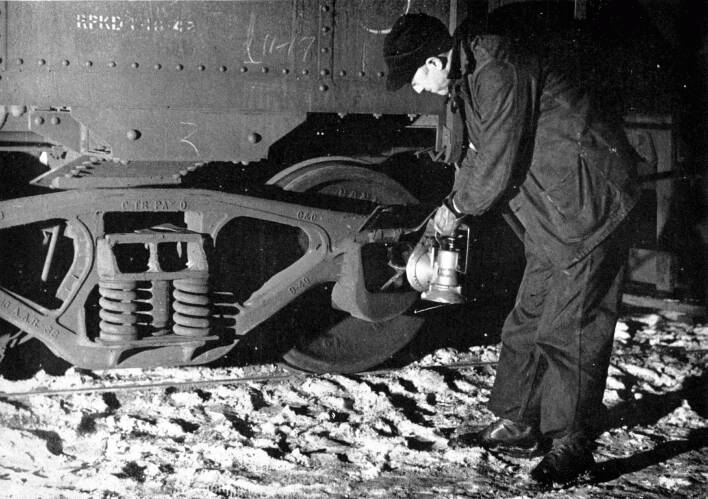 The Car Inspector at Work
The Car Inspector at Work
The car inspector is one railroad man who is always "looking
for trouble." He is also looking for ways to promote safety.
His job is to examine the cars to make certain that they are in
good condition, or to discover defects which might lead to accidents
or delays. He must have sharp eyes, keen ears and an alert mind
as he goes up and down the train tapping wheels and axles and
looking for defects.
This picture shows the car inspector examining the journal
box to see if it is properly packed with oiled cotton waste. A
journal box which is not adequately packed and oiled is likely
to become overheated from friction, and this may make it necessary
for the train to stop until it cools off.
Incoming passenger and freight trains at important stations
and yards are examined carefully. Under, around, inside and on
top of the cars the inspector clambers, his expert eye searching
trucks, gears and other parts for signs of defects. Inside the
cars, he notes the condition of roofs, walls, floors and doors.
He reads the "air date" to see if the air-brake apparatus
has been cleaned within the year. Tests are made before each train
leaves its home terminal and when cars are added to or taken out
of the train to see that the air-brake system is functioning properly.
At almost any hour one or more car inspectors may be seen about
the station and yards of important terminals, carrying their kits
of tools, and their lanterns at night, testing brakes and hose
connections, examining journal boxes or listening for flaws as
they tap their hammers against wheels, pipes and couplings. Cars
which do not meet the severest service requirements are ordered
out of the train for repairs. Every effort is made, however, to
keep loaded freight cars moving and to avoid delays which might
damage the contents of the cars or cause inconvenience to the
consignees. Of course, many cars travel empty on their way to
pick up loads. Such cars can usually be sent to the repair tracks
without undue inconvenience.
Car inspection is a part of the daily routine of railroad operations.
It is one of many precautionary measures which the railroads employ
to promote safety, prevent delays and increase the efficiency
of passenger and freight train operations. For many years "Safety
First" has been the watchword of every railroad and every
railroad employee. And today the railroads are providing the American
people with their safest form of transportation.
Freight car repairs fall into three classes—(1) tinker
repairs, (2) light repairs, and (3) heavy repairs. Tinker repairs
are inconsequential repairs from the standpoint of expense and
are usually made in the railroad yards without interfering with
the service of the car. Light repairs consist of running repairs
necessary to keep the car in service without material delay. They
are usually made in the car repair yard. Heavy repairs consist
of rather extensive overhauling and may include the renewal of
one or more of the following: wheels, truck bolsters, flooring,
sidings, roof, springs, air-brake equipment, couplings or draft
beams.
Passenger car repairs are classed as (1) running repairs and
(2) general repairs. Running repairs consist of minor work required
to keep the car in service without material delay. General repairs
call for more extensive work which may include renewal of wheels,
air-brake equipment, seats or upholstery, springs, axles, or interior
refurnishings.
Nearly every freight and passenger terminal has a repair yard
for performing light or running repairs. Heavy or general repair
work is performed at the larger car shops.
The railroads rely upon the expert eye or ear of the car inspector
to locate defective equipment. When he finds anything wrong, he
promptly notifies the foreman in charge of car repairs, and the
latter takes immediate steps to have the repairs made. In this
way, the railroads' great fleet of passenger, freight, express
and mail cars is kept in good condition.
Among the workmen who are employed in keeping railway cars
in good condition are: car foreman, car repairers, machinists,
machinists' helpers, welders, riveters, blacksmiths blacksmiths'
helpers, carpenters, carpenters' helpers, metal workers, machine
operators and painters. In addition to those mentioned above,
electricians, upholsterers and plumbers are employed' in the rebuilding
and repair of passenger train cars.
I've Been Working
on the Railroad | Contents Page
|







